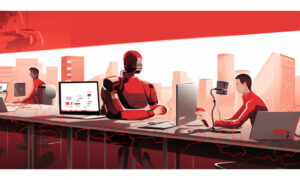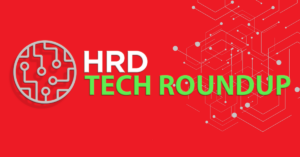Why you should be working more like your tech team
- 8 Min Read
Chances are, when you think of a typical tech team your mind starts conjuring images of bulky headphones, gadgets galore and t-shirts with quirky slogans. But whether you care to admit it or not, you’re probably also jealous of tech’s ability to focus on one task a time, prioritise their workload and bring together a team of specialists to complete big projects. Why not start working like that?
- Author: Tarquin Hellier
- Date published: Nov 15, 2018
- Categories

 This way of working isn’t unique to tech teams. By using ‘lean’ and ‘agile’ methodologies, tech teams have found measurable ways of fostering better communication, surfacing insights to achieve outcomes and pulling levers to drive continuous improvement – things every manager can put to use in their team, no matter what field they work in.
This way of working isn’t unique to tech teams. By using ‘lean’ and ‘agile’ methodologies, tech teams have found measurable ways of fostering better communication, surfacing insights to achieve outcomes and pulling levers to drive continuous improvement – things every manager can put to use in their team, no matter what field they work in.
In my role at MVF, a leading customer generation company, I’ve been sharing the principles of lean and agile working with our teams to help them streamline their processes and increase productivity.
Innovation on the production line: quality is more important than speed
It makes sense that tech’s modern ways of working are able to transcend sectors since the principles themselves actually originated from an unlikely place – the manufacturing line.
In post World War II Japan manufacturers were facing many challenges – low budgets, minimal space and high unemployment to name a few. The team at Toyota overcame these challenges be creating the concept of lean manufacturing. This meant putting more emphasis on humans doing creative problem solving while automating repetitive tasks.
The team created a detailed review of the process of building a car to surface all areas of potential ‘waste’ and minimise it through continuous improvement. Most importantly, the team focused on root cause analysis and outcomes, rather than the emphasis on speed, repetition and economies of scale that was the hallmark of their American counterparts – popularised by the production lines developed by Henry Ford.
For example, while American production lines rarely stopped because there were quotas to fill – often resulting in an entire batch being faulty as defaults were then mass produced – the Japanese production line stopped frequently so defaults or issues could be solved at the time, decreasing the volume of production but vastly improving quality by making continuous improvements in the overall process.
Business and management experts across the world have learned from Toyota’s story and started implementing the principles into their way of working, but the tech world have truly embraced it, creating their own model for working using similar principles.
From production floor to technology team
When corporations and governments started investing in large software projects in the 70s and 80s they faced the challenge that numerous of these projects failed to deliver the value or impact promised and often were horrendously over budget.
The answer was Agile software development. This means working with the customer daily (collaboration), delivering working software (value) by working in small batches (iteratively) so you get feedback early on and can adjust accordingly (agility). You might be familiar with the concept of ‘MVP’ or minimum viable product, which means a version of the end product that is far from perfect, but can be used to make the finished version better in collaboration with the end user.
These concepts are heavily influenced by Toyota’s practices, transferred from the production line to the software development room.
Learn and agile: how to prioritise quality and continuous collaboration in your team
Lean and agile are often heard together, but describe slightly different concepts. While both discuss delivering outcomes for customers Lean, as we’ve learned from Toyota, is all about eliminating waste and continuous improvement. Agile, on the other hand, is about clear communication and flexibility.
Together, lean and agile working make for optimised, innovative and quality outcomes. Most tech teams today use a hybrid of the two concepts in the way they work.
These principles aren’t just for tech, though, there are simple changes all managers can make to the way they build and deploy their teams to tackle problems and start projects that can help us all achieve optimised, innovative and quality outcomes.
To embrace lean and agile in your own teams, there are four areas you should focus on.
- Better communication
Historically, one of the biggest problems in tech is that we simply don’t talk enough. I’m sure this rings true for many other teams who work collaboratively on projects with multiple stakeholders. To fix this, we have to change how we work to better discuss and solve problems as a team.
It’s simple a simple solution – better face to face communication across a team gives better knowledge of a project, more solutions and more efficient results. Think about making your outcomes, progress against these and the tasks required visible to all, not just a few, to start open and honest debate about the right approaches and the problems you face.
- Measure outcomes
Always remember to look at the bigger picture to form a long-term view of outcomes and success. Just like the team at Toyota, you need to make sure you are measuring the right metrics – delivering one quality car that meets the client need rather than one hundred finished cars, each with a default.
To do this, break down a project into smaller deliverables then measure each deliverable throughout each stage of the process. By tracking a project on what may seem like a granular level, we’ve actually found team members are able to complete each deliverable quicker, and at a higher standard. Go slow to go fast.
- Continuous improvement
To build a culture of continuous improvement managers have to first recognise one important but sometimes difficult truth: things probably aren’t perfect. Once this is a fact of life, teams are able to be honest about that and work out where they can find improvements.
It’s important this is done using real data, which is why it’s also so important to measure each deliverable. With this data to hand, we hold a retrospective each week to learn why things did or didn’t achieve the outcome and work together to conduct root cause analysis to fix the issue and prevent it from happening on the next project.
- Work as a team, not individuals
Measure the outcomes from the team, not from individuals. By using teamwork, teaching each other and sharing skills we create multi discipline individuals who can tackle a multitude of problems, not just one. We call this T-shaped people, people with lots of skills and a specialism in one. It provides teams with the agility to solve lots of different problems.
Case Study: Recruitment
MVF’s tech team was tasked with helping it’s talent team overhaul its recruitment process to get more quality hires, quicker.
Start with the goal
Reduce the time to hire from 35 days to 7 days. Ensure hires meet quality guidelines – they stay for the long term.
Analyse the existing process
MVF’s normal hiring process was similar to most other companies:
- write a job specification
- advertise the position for a predetermined time frame
- review applicants
- phone applicants
- shortlist candidates – determining capability
- interviewing process – determining quality
- offer to the highest quality candidate still remaining at the end of the process
How far away is the goal from where we are now?
The process takes weeks and the most important part of the process for making an informed decision – the final interview comprising the hardest questions and requirements – is right at the end of the cycle. We could be losing quality hires who receive another offer while we are still assessing capability rather than quality.
Measure the process everywhere
We measured each stage of this cycle and evaluated its impact on the overall outcome we were looking for – quality hires, quickly, who stay for the long-term. As a customer generation firm we know that the time taken to respond to an inbound request is directly correlated to the final outcome – the sale. Therefore we realised that we needed to respond to applications the same day, ideally within an hour. Applicant engagement went through the roof.
Identify waste
We found that we could reduce the time spent on the early stages by having some of our hardest or most demanding requirements at the start of the process. We eliminated a large proportion of candidates this way and had greater confidence those remaining. With fewer candidates, we were able to interview them much faster. This fast feedback cycle allowed us to tweak job ads and refine our requirements to improve the pipeline as applications came through.
Identify innovation
We designed a face to face interview process that allowed us to capture the information we needed in a single stage, including a peer session where the candidate meets several members of the team for both skills and culture fit analysis. This resulted in our overall face to face interview time being reduced to three hours and, most importantly, no waiting time between stages.
Experiment and improve until you reach your goal
Once we made these two changes, we applied our continuous improvement mindset to assess the success of the entire process at the end of each hiring cycle: work out why certain candidates weren’t successful in the role and what can we change about the process to limit this from happening again.
Celebrate
We found that by being quick off the mark, we were getting a competitive edge and securing top talent before they even had a chance to start the hiring process with our competitors. We reduced the application to offer timeline from 35 days to just seven days, saving multiple stakeholders hours in work and giving our candidates a great recruitment experience.
Tarquin Hellier is Director of Engineering at MVF









